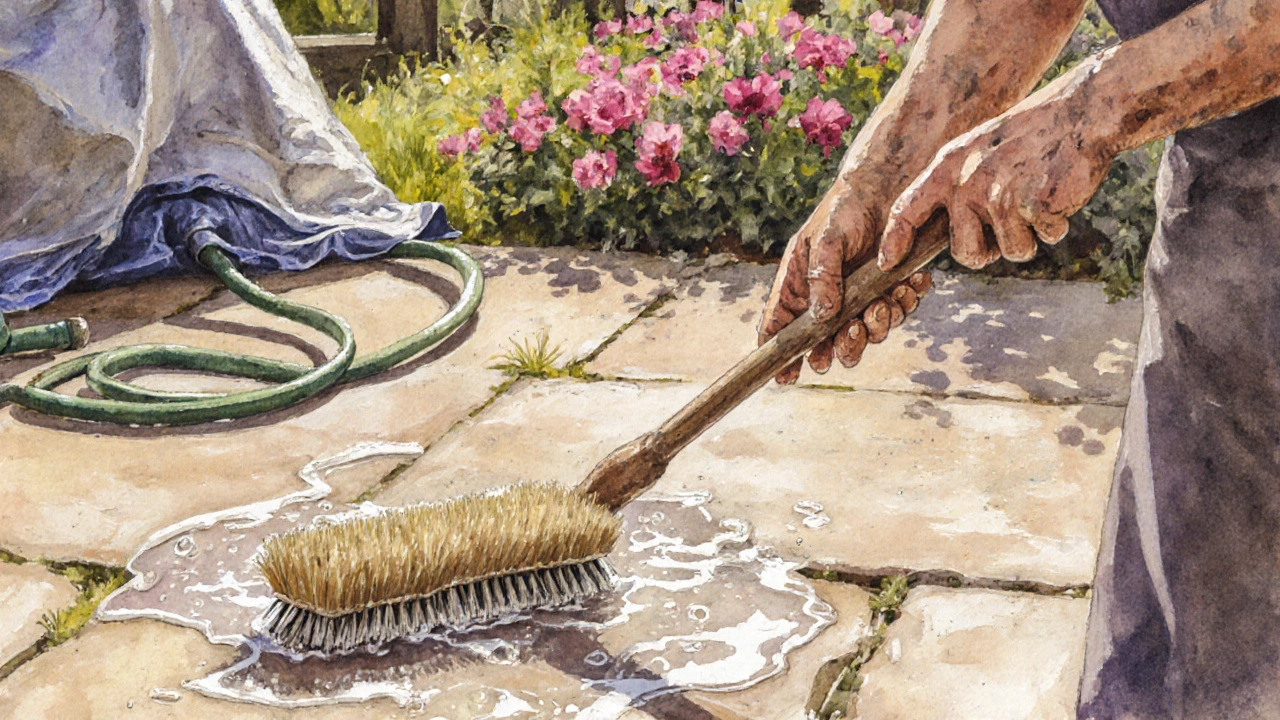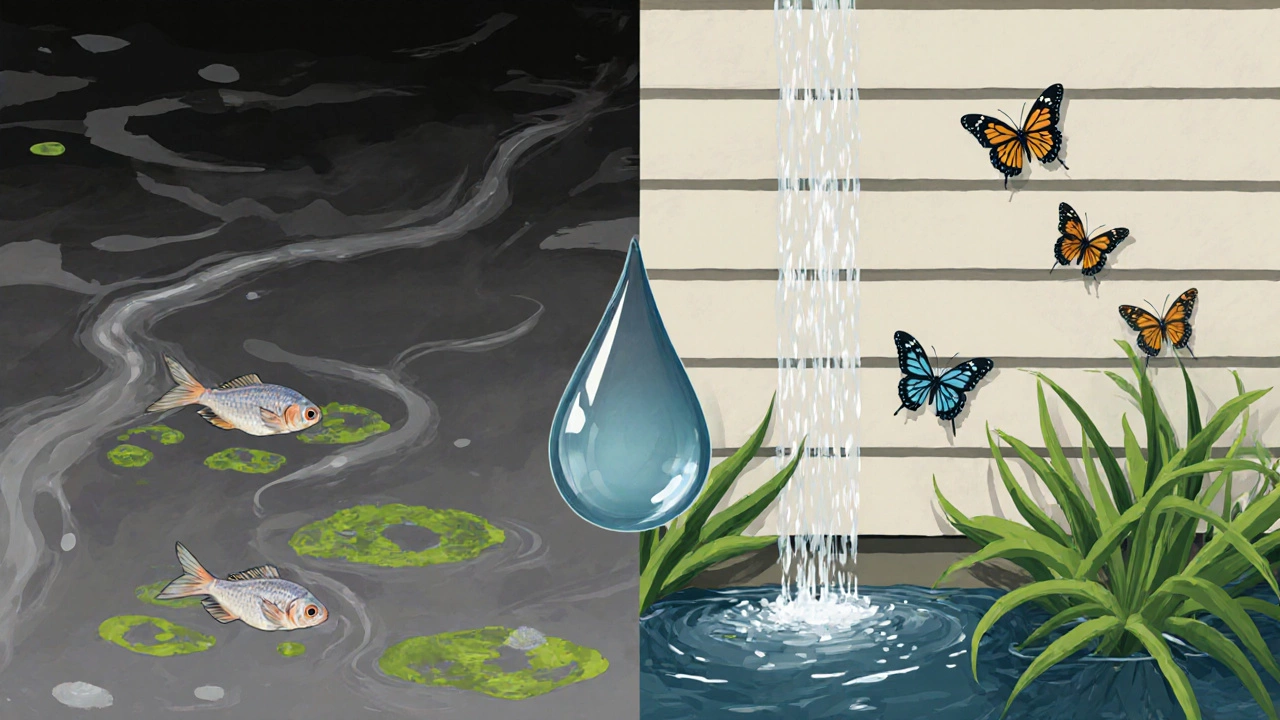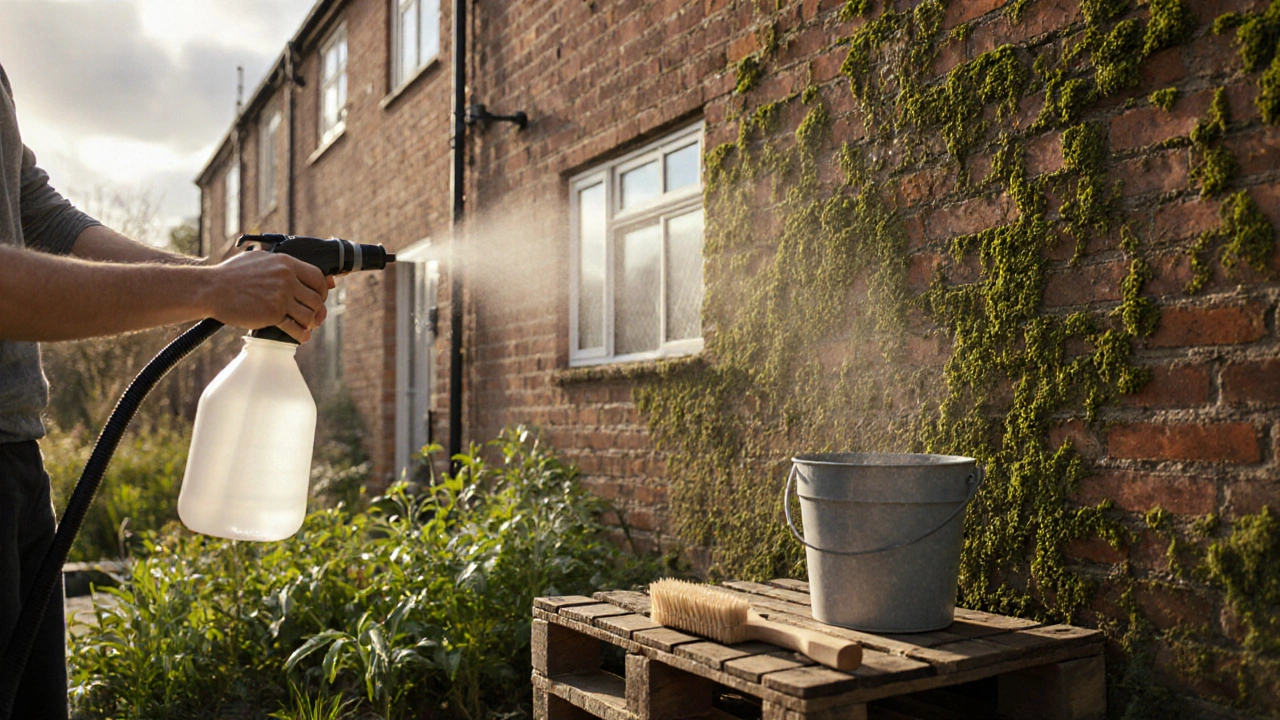House Washing Solution Calculator
Eco-Friendly Cleaning Calculator
Determine the perfect solution ratio for your house washing needs using natural ingredients.
Estimated Results
Safety Information
Washing your house doesn’t have to mean harsh chemicals, loud pressure washers, or runoff that kills your garden. If you’re asking what the best thing to wash your house with is, you’re not just looking for clean walls-you’re looking for a solution that protects your family, your plants, and the local waterways. The truth? The best thing to wash your house with isn’t a product you buy in a big plastic bottle. It’s a simple mix you can make right now with things already in your kitchen cupboard.
Why Regular Cleaners Don’t Work for House Washing
Most store-bought house cleaners are built for speed, not safety. They contain sodium hypochlorite (bleach), phosphates, or synthetic surfactants that strip dirt fast but also kill moss, algae, and beneficial bacteria in your soil. In Bristol, where rain is frequent and gardens thrive, those chemicals don’t just disappear-they wash into drains, then into the Avon River. A 2023 study by the UK Environment Agency found that 42% of urban runoff in southwest England contained traces of chlorine-based cleaners, linked to reduced aquatic insect populations.
Plus, bleach damages brick, stone, and wood over time. It fades paint, weakens mortar, and leaves a chalky residue that attracts dirt faster than before. You’re not cleaning-you’re accelerating decay.
The Real Best Thing: Vinegar, Baking Soda, and Water
The most effective, safest, and cheapest solution for washing your house is a blend of white vinegar, baking soda, and water. This isn’t a hack. It’s how generations of British homeowners cleaned their terraces, cottages, and garden walls before synthetic cleaners existed.
Here’s the recipe:
- 1 gallon of warm water
- 1 cup of white vinegar (5% acidity)
- 1/2 cup of baking soda
- Optional: 10 drops of tea tree oil (natural antifungal)
Mix the vinegar and water first. Then slowly stir in the baking soda-it will fizz. Let it settle for a minute before adding tea tree oil if you’re using it. Pour into a spray bottle or use a garden sprayer with a wide nozzle.
Apply it to dry surfaces. Let it sit for 10-15 minutes. Scrub gently with a soft-bristle brush-no power washer needed. Rinse with a hose on low pressure. You’ll remove mold, mildew, algae, and grime without harming plants or pets.
Why This Works Better Than Bleach
Vinegar is acidic enough to break down organic gunk like algae and lichen, but not strong enough to corrode brick or render. Baking soda acts as a gentle abrasive and deodorizer. Together, they lift dirt without stripping surfaces. Unlike bleach, this mix doesn’t produce toxic fumes. You can use it on uPVC, wood, stone, and even painted surfaces.
And here’s the kicker: it costs less than £1 per gallon. A 500ml bottle of vinegar from the supermarket costs around 30p. Baking soda? 50p for a kilo. That’s 100 washes for under £5.
When You Might Need Something Stronger
If your house has thick, black mold on south-facing walls or decades-old lichen on stone, vinegar and baking soda might need backup. In those cases, use oxygen bleach-yes, it’s a real thing.
Oxygen bleach (sodium percarbonate) is not chlorine bleach. It breaks down into oxygen, water, and soda ash. It’s used in eco-friendly laundry detergents and is safe for plants and pets when rinsed properly. Brands like OxiClean Eco-Friendly or Biokleen Bac-Out work well.
Use it at a ratio of 1/2 cup per gallon of warm water. Apply, let sit for 20 minutes, scrub, rinse. No fumes. No residue. No harm to your garden.
Never mix oxygen bleach with vinegar or ammonia. It creates a chemical reaction that reduces effectiveness and can release gas.

Tools You Actually Need
You don’t need a £500 pressure washer. In fact, pressure washers can damage older brickwork and force water behind cladding, leading to rot. What you do need:
- A garden sprayer (plastic, with adjustable nozzle)
- A long-handled soft-bristle brush (for walls and eaves)
- A bucket
- A hose with a spray trigger
- Gloves and eye protection (yes, even with natural cleaners)
For tall walls, use a telescopic brush like the Ettore MasterClean or a simple mop on a pole. You can clean your entire two-story house in a weekend with these tools.
What Not to Use
Here’s a quick list of things that seem like good ideas but aren’t:
- Undiluted bleach: Destroys mortar, kills soil microbes, stains stone.
- Ammonia-based cleaners: Toxic fumes, harmful to pets, reacts badly with vinegar.
- Commercial ‘mould removers’: Often contain chlorine or quaternary ammonium compounds-both linked to respiratory issues.
- Pressure washing on old brick or render: Can erode surfaces, force water into cavities, cause long-term damp.
- Steam cleaners on wood or painted surfaces: Can warp wood and peel paint.
Seasonal Tips for Bristol Homes
Washing your house isn’t a once-a-year chore. In Bristol’s damp climate, algae and moss grow fast-especially on north-facing walls and under eaves.
Spring (March-May): Clean before the rainy season hits. This prevents algae from setting in.
Autumn (September-November): Remove leaves and debris from gutters and walls. Wet leaves trap moisture and encourage mold.
Winter (December-February): Avoid cleaning when temperatures are below 4°C. Water can freeze in cracks and cause spalling.
Check your walls every 6 months. If you see green patches, clean them early. It’s easier to remove a thin layer of algae than a thick, root-like mat.
Protect Your Garden While Cleaning
Even eco-friendly cleaners can harm plants if they’re soaked in runoff. Before you start:
- Water your plants thoroughly-wet soil absorbs chemicals better.
- Use a tarp or plastic sheet to cover flower beds and shrubs near the wall.
- Direct runoff away from garden areas into drains or lawns.
- After rinsing, give your plants a quick rinse with clean water.
Some gardeners swear by spraying a thin layer of diluted seaweed extract on plants before cleaning. It acts as a protective barrier against mild chemical exposure.

What About Commercial Eco-Cleaners?
There are brands that market themselves as ‘eco-friendly’-but not all are trustworthy. Look for certifications:
- EU Ecolabel: Strict standards for biodegradability and toxicity.
- Ecocert: Certified organic and non-toxic.
- Leaping Bunny: No animal testing.
Brands like Ecover, Method, and Eco-Me have reliable exterior cleaners. But they cost 5-10 times more than homemade solutions. Unless you’re cleaning a listed building or delicate stonework, you don’t need them.
Real Results from Real Homes
In Clifton, a homeowner cleaned her 1870s terraced house with vinegar and baking soda. Her walls had green streaks from 20 years of algae. After two applications, the grime lifted. She didn’t use a pressure washer. Her garden survived. Her paint stayed intact. And she spent £3.50 total.
Another family in Totterdown used oxygen bleach on their stone porch. The black lichen vanished. Their dog could walk on it the same day. No chemical smell. No warning signs on the gate.
You don’t need expensive gear or professional services. You need consistency, the right tools, and a willingness to skip the toxic stuff.
Final Answer: What’s the Best Thing to Wash Your House With?
The best thing to wash your house with is a mix of white vinegar, baking soda, and water. It’s safe, cheap, effective, and kind to the planet. For stubborn stains, add oxygen bleach. Skip the bleach. Skip the pressure washer. Skip the overpriced bottles with green labels.
Your house doesn’t need to be spotless-it needs to be healthy. And so does everything around it.
Can I use vinegar on brick walls?
Yes, vinegar is safe for most brick walls, especially if diluted. Avoid using it on limestone, marble, or sandstone, as the acid can etch these softer stones. For brick, a 1:1 vinegar-to-water mix works well. Always rinse thoroughly after cleaning.
Will baking soda scratch my siding?
No, baking soda is a very mild abrasive. It won’t scratch uPVC, wood, or painted surfaces when used with a soft brush. It’s much gentler than sand or commercial scrubbing powders. Just avoid using it with a stiff wire brush.
How often should I wash my house?
In damp climates like Bristol, clean your house every 12-18 months. If you see green or black patches, clean them as soon as possible. Early removal prevents deeper staining and structural damage. Don’t wait until it looks bad-clean before it becomes a problem.
Is oxygen bleach safe for plants?
Yes, oxygen bleach is safe for plants when used correctly. It breaks down into water, oxygen, and soda ash-all harmless to soil and vegetation. Always rinse plants after cleaning, and avoid direct spraying on leaves. It’s far safer than chlorine bleach.
Can I use this method on roof tiles?
Yes, but be cautious. Roof tiles are fragile. Never use a pressure washer. Apply the vinegar and baking soda solution with a sprayer, let it sit, then rinse gently with a hose. Work from the top down to avoid streaks. For moss-heavy roofs, consider hiring a professional who uses soft washing techniques.
Next Steps
Start small. Pick one wall-maybe your front porch or garden shed. Mix the vinegar and baking soda solution this weekend. Clean it by hand. See how easy it is. Then move to the next section. You’ll save money, reduce plastic waste, and protect your local ecosystem.
And if you ever feel tempted to reach for that bleach bottle, remember: the cleanest house isn’t the whitest one. It’s the one that doesn’t poison the ground beneath it.
